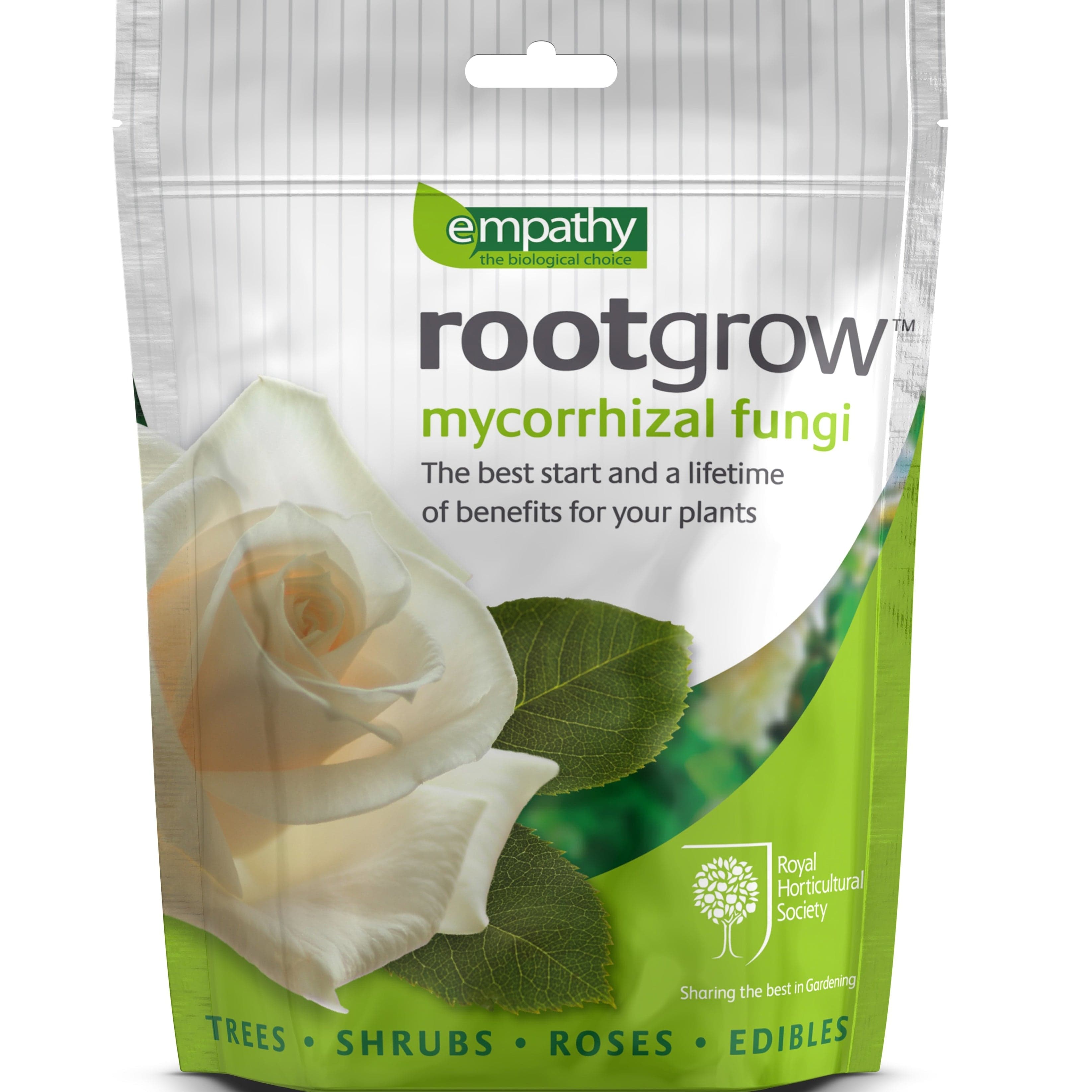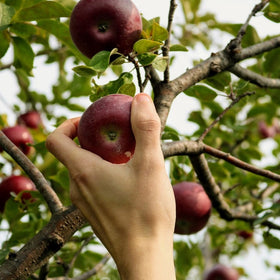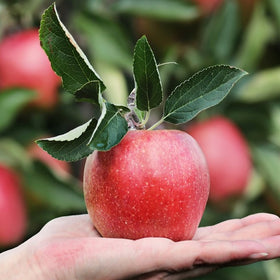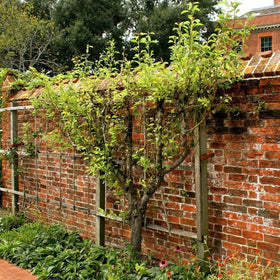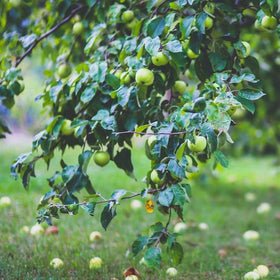







The highlights
- Excellent flavour with a fresh, aromatic taste.
- One of the most popular varieties to grow at home
- Very easy to grow & stores well into the new year
- Late season - harvest September to October
Description
- Thought Braeburns couldn't be improved on? Hold my apple juice...
- Meet Braeburn Hillwell, basically it's Braeburn 2:0. An improved sport (mutation) of Braeburn with better flavour, colour and suitability to the UK climate.
- The improvement has resulted in a perfectly sized, crisp red eating apple with wonderful aromatic flavour which grows on a compact, low maintenance tree
- Harvest your apples from October to early November. Braeburn Hillwell is an excellent keeper that can be stored right through to March
- Self fertile - will produce good crops even with no other trees nearby
- Awarded RHS Plants for Pollinators status for its appeal to bees and other pollinating insects
- Best grown in a sunny, sheltered spot
- M26 Rootstock - Max size H3m x W3m
- MM106 Rootstock - Max size H4m x W4m
- Our potted trees are supplied in EcoPots™.
- Our trees are usually between 18 and 36 months old at the time of dispatch.
- Our trees are professionally pruned before dispatching.
Read more
What To Expect
Supplied as:
Height on arrival:
Eventual height:
Eventual spread:
Tasting notes:
Time to first crop:
Flower colour:
Habit:
Hardiness:
Self fertile:
Pollination group:
Uses:
Rootstock:
Spacing:
How To Grow

Prone to aphids
Clear a 60cm radius at the base of the tree and keep. weeds to a minimum. Introduce aphid predators to your garden using companion planting, you can read more about companion planting in our knowledge section.MORE

Water in well when planting - read on for ongoing care
Water in thoroughly when planting. For bare root trees, you won't need to water regularly going forward, only water in dry spells when needed. You should be able tell because the leaves will start to wilt and droop. If a container grown tree, it will need more watering until its roots are established. It should be watered every other day or so for the first few months. Then reduce to twice a week until autumn. In the second year it should have a established enough root system to support itself, just water when required as explainded above for bare roots. When watering a tree it is important to give a good soaking. It is better to water heavy and less frequently than little and often as this encourages the roots to grow down into the ground.

Full sun to partial shade
Plant the tree in a sheltered west or south-facing position that recieves full sun to partial shade

Clay, Loam & Sand
This tree needs a moderately fertile soil that is well drained

No need to feed
.
Planting Calendar
- Best time to plant
- Harvest
- Flower
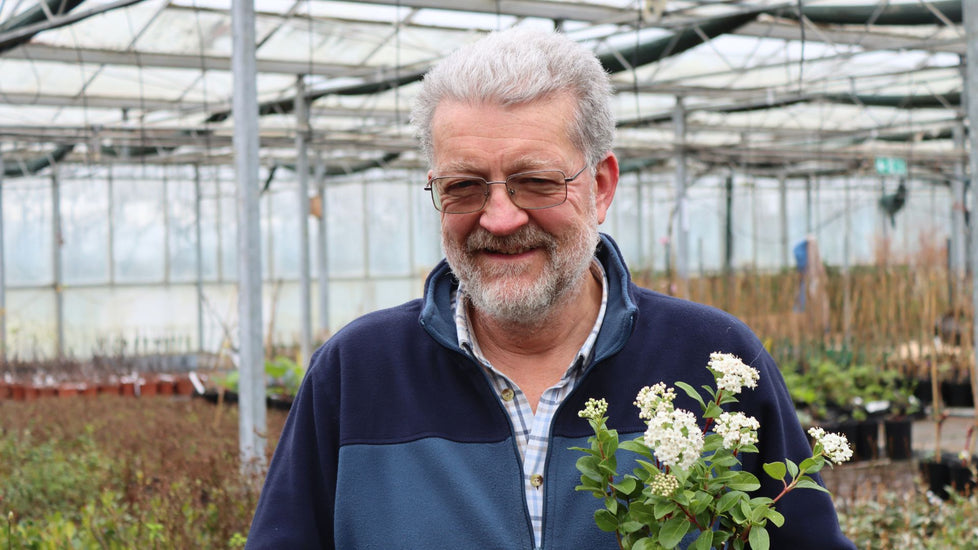
South Downs National Park
Meet John
110 years' expertise free with every tree
John’s family have been growing trees in the South Downs National Park for over a century, and it shows. Dug up and sent straight to your garden at between 18-36 months old, their quality rootstocks, expert pruning and natural pest control mean that these traditionally field-grown trees are the hardiest you can get.
What customers say about us
We do our best to provide you the best experience ever
Growing with Roots
Good to know
Our plants are grown in the UK
Specialist UK growers we know and trust grow your plants the traditional way, with organic fertiliser and biological pest control. They pick only the healthiest plants for you, professionally pruning them so that they’ll grow strong and well shaped.
Our plants are delivered overnight
Your plants are sent to you fresh from the field in our plastic free box that’s specially designed to hold them tight, then securely delivered by specialist plant couriers - straight from the grower to your garden within 24 hours.
We’re here to help at every step
We want your plants to have a long and healthy life. Expect easy-to-follow grow guides and videos devised by our team of experts.
Perfect plants, guaranteed
We’re confident that you’ll be delighted with your new plants. Need help? Alice and her team are here to guarantee you’re perfectly happy.
Similar collections
Learn from our experts
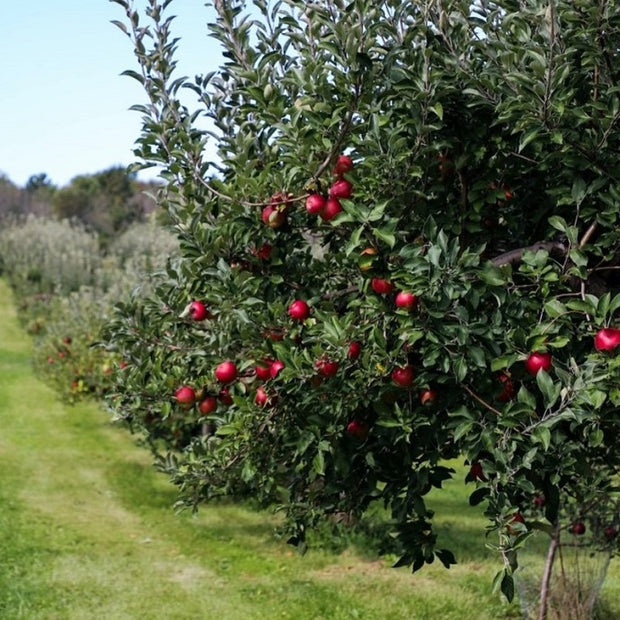
Planting Apple Trees: The Complete Guide
Digging deep to answer your questions
How do I know I'm getting quality plants?
All of our plants are grown in specialist nurseries with the highest standards of plant care and sustainability. We guarantee you'll love them as much as we do! Don't just take our word for it - we've got thousands of great reviews on Trustpilot.
When will I get my plants?
The delivery timescale for each plant is on the web page (near the 'add to basket's button). You'll receive a dispatch email with an exact delivery date once your plants are on their way, so you can get the garden ready.
How will my plants be packed and delivered?
We send all of our orders through a courier network designed to handle plants. Specialist equipment ensures that no plants will be damaged during the packing process and every order is carefully finished and checked by plant-loving humans. Your plants will arrive in the most sustainable packaging possible with minimal to no plastic used.
Where do you deliver?
We deliver to anywhere in Mainland UK for our standard delivery cost. We are able to deliver most plants to Highlands and non UK mainland however this will be at an additional cost. This will be calculated at the checkout. Please note, deliveries to these locations will take longer. Unfortunately, we are not able to deliver to Northern Ireland at present.
Ask the grower
One of our trusted growers will get back to you via email within 24 hours
What customers say about us
We do our best to provide you the best experience ever
Excellent delivery and service
Well, the delivery was spot on, the tree looks healthy enough for a sleeping plant, although at the moment most of the branches are on one side of the trunk which in itself is bent banana-style. quite wonky. One can only hope that it grows into a fruitful plant with some character?
30 January
Nice sized tree in good condition
Time will tell on the quality of the product (bare-root apple trees), but the stems that arrived seemed in great condition and very well packaged so no damage in transit. Looking forward to Spring!
Ange
Appears v healthy
Very happy with purchase
Ms Arlene Bocking
Lovely tree
So happy with my purchase of my Braeburn Hillwell apple tree from Roots Plants. It arrived promptly, well packaged and in a good, healthy condition. I soaked it for an hour before planting and it's doing well. Looking forward to our home grown apples, in time.
Ms Arlene Bocking
It has picked up now and is growing well
It arrived in a heat wave and looked a little bit sorry for itself when planted out but it has picked up now and is growing well.
David Osborne
Good service all round
Arrived on time as the seller said it would and the courier gave me a time slot to track my parcel. It came well packaged and was of good quality for this time of year. It looks a good and healthy tree and will be planted up in a few weeks after the ground has been prepared. I’m pleased with my purchase.
Helen
